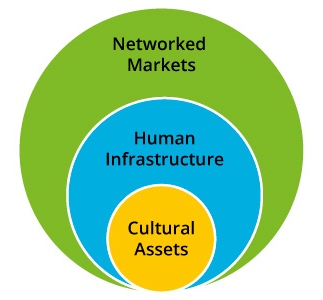An index measuring pre-conditions for an innovation economy.
Please see the 2018 version of this document for the latest information.
Innovation pre-conditions are based on a 3 factor score aligned to process of innovation — turning ideas into implemented and communicated innovations. The 3 factor scores are derived from consulting 162 indicators with benchmark scores. Being a broad-based index, these indicators cover all 31 industry segments within a major city. These in turn, are derived from 1200 data point variables selected from 2thinknow’s City Benchmarking Data. This is termed the Innovation Cities™ Framework, the largest of it’s kind, established in 2007, expanded in 2010.
Our commercial quality data is sold to business and others for investment decisions, and also used in the Index.
Additionally, learn more about Classifications and Benchmark Scores (external link), or current FAQ and Media Release
3 Factors which Model an Innovation Economy.
Cities in the Innovation Cities™ Index are scored for innovation on 3 factors that capture the innovation process. The 3 factors are:
 Cultural Assets: Measurable sources of ideas (e.g. designers, art galleries, sports, museums, dance, nature, etc)
Cultural Assets: Measurable sources of ideas (e.g. designers, art galleries, sports, museums, dance, nature, etc)
Human Infrastructure: Soft and hard infrastructure to implement innovation (transport, universities, business, venture capital, office space, government, technology, etc.)
Networked Markets: Basic conditions and connections for innovation (location, military, economies of related entities etc)
These 3 factors are based on 2thinknow’s extensive model of the stages of innovation process. In short, as innovation moves from idea to implementation and then, communication.
The 3 factors measure the preconditions for turning an innovative idea into an implemented successful global (or regional) innovation, using the 2thinknow Innovation Development Life Cycle model developed in 2006-7.
In short, the model is based on ideas, implementation and communication with a 4th phase used to assess feasibility. This model is taught in the Innovation Course for business and cities and has been published since the 2007 edition of our report.
The idea allows cities to turn ideas into innovation with a structured process, and is unique to 2thinknow.
4 Innovation Classifications.
Based on their 3 factor score, all cities are graded into award categories.
Please see the Classification explanation here.
Regions.
The cities are classified into 4 regions. Since 2012, these regions are further divided into subregions. These regions and subregions are as follows:
AMERICAS: USA, Canada and Latin America
EUROPE: Euro Cont (includes Turkey and Israel) and Russia
ASIA: Asia, China, India, Japan and ANZ (Australia & NZ)
EMERGING: Mid-East, Africa, and Eurasia
The Innovation Cities Index can be analyzed by regions as well as by subregions.
For more details.
Purchase City Benchmarking Data: All data for a single city or a mix of indicators to compare cities.
Read the Innovation Cities™ Analysis Report to understand the underlying framework and thinking.
Or select a Service Package for a package of analysis on cities.
Methodology in brief.
The Index is the most comprehensive city ranking and scoring. Each city was selected from 1,700+ cities based on basic factors of health, wealth, population, geography as well as potential relative to peers. The final cities in 2016-2017 had data extracted on 162 indicators under the city benchmarking data program. Each of the benchmarking data was scored by analysts using best available qualitative analysis and quantitative statistics (see City Benchmarking Data to purchase city data).
Underlying data was then balanced against current global trends, by analysts to form a simplified 3 factor score for Cultural Assets, Human Infrastructure and Networked Markets. For city classification, these scores were competitively graded into 4 bands (Nexus, Hub, Node, Upstart) based on how broad based (multiple indicators) the city performance was.
The top scored cities (top third) were allocated as Nexus and Hub were ranked by analysts based on comparison of current innovation potential. A Node classification is considered ‘globally competitive’.
From this global Index 4 regional indexes for Americas, Europe, Asia and Emerging are then also produced, and 13 sub region indexes also.
The ranking was completed on the scored and classified cities using 2thinknow trend analysis techniques. The trend assumptions used are outlined as ‘Key Trends’ in the Innovation Cities Analysis Report.
Please note the full list on the index page is classified and ranked.. Rankings are just for general information. ‘
A Key Findings Summary report on release is available to subscribers and journalists only.
More discussion and questions answered in this extensive FAQ but for full details, order the Innovation Cities Analysis Report.
About 2thinknow Innovation Cities™ Program.
Based in Melbourne Australia, 2thinknow is the world’s first innovation agency. Established 2006, we have designed original models to measure and deliver innovation to cities, business seeking new markets and growth, and NGO/government clients.
2thinknow’s Innovation Cities™ Program provides powerful tools for creating an innovation economy. This includes the City Benchmarking Data™ details on cities by segment globally, analyst reports such as the flagship Innovation Cities™ Analysis Report. In the Innovation Course, we are teaching our clients new innovation methods and practices. 2thinknow work with other clients through innovation consulting, analyst reports, projects and innovation services, as well as a number of online resources and groups.
2thinknow have published the Innovation Cities™ Indexes city rankings free online since 2007.
This is 500 cities since 2015, and is the world’s largest and most diverse city index.
Contact 2thinknow here: https://innovation-cities.com/enquire/ or via twitter @2thinknow
